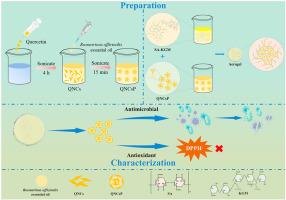Sodium alginate-konjac glucomannan-based aerogel preservation pad with the quercetin-stabilized Pickering emulsion: preparation, characterization and application in beef preservation
IF 11
1区 农林科学
Q1 CHEMISTRY, APPLIED
引用次数: 0
Abstract
Aerogels, owing to their lightweight structure and tunable functionality, have recently emerged as promising candidates for active food packaging applications. In this study, a novel bio-based aerogel preservation pad was developed by incorporating a quercetin-encapsulated Rosmarinus officinalis essential oil Pickering emulsion (QNCsP) into a sodium alginate (SA)-konjac glucomannan (KGM) aerogel matrix. The incorporation of QNCsP enhanced the structural integrity of the aerogel, resulting in a more compact and homogeneous three-dimensional network. The bulk density of the optimized SA-KGM/QNCsP3 aerogel reached 14.398 ± 0.455 mg/cm3, which was approximately 59.33 % higher than that of the SA-KGM control. In addition, the SA-KGM/QNCsP aerogel also exhibited significantly higher mechanical strength than the SA-KGM control. The sustained release of QNCsP endowed the aerogel with pronounced antioxidant and antimicrobial activities. Application in beef preservation demonstrated that the SA-KGM/QNCsP3 aerogel effectively inhibited spoilage, with the TVB-N value maintained at 6.057 mg/100 g after 7 d of storage, which represented a 68.66 % reduction compared with the control group. Furthermore, the aerogel reduced weight loss and enhanced the color stability of beef throughout the storage period. Overall, the SA-KGM/QNCsP3 aerogel preservation pad presents a safe, biodegradable, and multifunctional approach for extending the shelf life and improving the quality of perishable foods, offering promising potential for sustainable food packaging applications.

海藻酸钠-魔芋葡甘露聚糖基气凝胶保存垫及槲皮素稳定酸洗乳的制备、表征及在牛肉保存中的应用
气凝胶由于其轻巧的结构和可调的功能,最近成为活性食品包装应用的有前途的候选者。本研究将槲皮素包封的迷迭香精油Pickering乳剂(QNCsP)加入海藻酸钠(SA)-魔芋葡甘露聚糖(KGM)气凝胶基质中,制备了一种新型生物基气凝胶保存垫。QNCsP的加入增强了气凝胶的结构完整性,形成了更紧凑、均匀的三维网络。优化后的SA-KGM/QNCsP3气凝胶体积密度达到14.398±0.455 mg/cm3,比SA-KGM对照提高59.33%。此外,SA-KGM/QNCsP气凝胶的机械强度也显著高于SA-KGM对照。QNCsP的缓释使气凝胶具有明显的抗氧化和抗菌活性。在牛肉保鲜中的应用表明,SA-KGM/QNCsP3气凝胶有效地抑制了牛肉的腐败,贮藏7 d后TVB-N值保持在6.057 mg/100 g,比对照组降低了68.66%。此外,气凝胶减少了牛肉的重量损失,提高了牛肉在整个储存期间的颜色稳定性。总体而言,SA-KGM/QNCsP3气凝胶保鲜垫具有安全、可生物降解和多功能的特点,可延长易腐食品的保质期和提高其质量,为可持续食品包装应用提供了广阔的前景。
本文章由计算机程序翻译,如有差异,请以英文原文为准。
求助全文
约1分钟内获得全文
求助全文
来源期刊

Food Hydrocolloids
工程技术-食品科技
CiteScore
19.90
自引率
14.00%
发文量
871
审稿时长
37 days
期刊介绍:
Food Hydrocolloids publishes original and innovative research focused on the characterization, functional properties, and applications of hydrocolloid materials used in food products. These hydrocolloids, defined as polysaccharides and proteins of commercial importance, are added to control aspects such as texture, stability, rheology, and sensory properties. The research's primary emphasis should be on the hydrocolloids themselves, with thorough descriptions of their source, nature, and physicochemical characteristics. Manuscripts are expected to clearly outline specific aims and objectives, include a fundamental discussion of research findings at the molecular level, and address the significance of the results. Studies on hydrocolloids in complex formulations should concentrate on their overall properties and mechanisms of action, while simple formulation development studies may not be considered for publication.
The main areas of interest are:
-Chemical and physicochemical characterisation
Thermal properties including glass transitions and conformational changes-
Rheological properties including viscosity, viscoelastic properties and gelation behaviour-
The influence on organoleptic properties-
Interfacial properties including stabilisation of dispersions, emulsions and foams-
Film forming properties with application to edible films and active packaging-
Encapsulation and controlled release of active compounds-
The influence on health including their role as dietary fibre-
Manipulation of hydrocolloid structure and functionality through chemical, biochemical and physical processes-
New hydrocolloids and hydrocolloid sources of commercial potential.
The Journal also publishes Review articles that provide an overview of the latest developments in topics of specific interest to researchers in this field of activity.
 求助内容:
求助内容: 应助结果提醒方式:
应助结果提醒方式:


